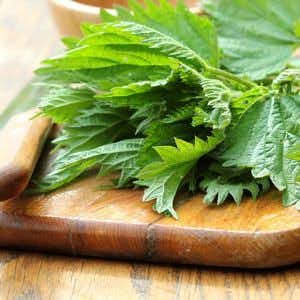
Stinging nettle is native to Europe, but it has become established in North America and now grows in Canada and throughout the United States.
It is best known for its ability to provoke an impressive rash (urticaria) that stings for up to twelve hours after contact with the tiny toxic hairs of the plant.
Stinging nettle must have been very popular at one time, because it has so many uses attributed to it by folk medicine.
It is not well known in this country, but in Europe both the leaves and the roots are listed in herbal medicine formularies. The tender shoots are harvested before they develop stinging hairs, cooked, and eaten as a vegetable.
According to tradition, the juice can stimulate hair growth if it is smeared on the scalp.
Active Ingredients
The leaves and other aboveground parts of stinging nettle are collected while the plant is flowering (from June to September). They contain several mineral salts, particularly those of calcium and potassium, as well as silicic acid (1 to 4 percent), some volatile oils, and a mixture of flavonoids (up to 1.8 percent).
Vitamins C and K and several B vitamins are present, with tender shoots being especially rich in vitamin C and carotene. The stinging hairs deliver histamine, formic acid (also found in ant stings), serotonin, and acetylcholine.
In the root, which is used for different purposes, beta-sitosterol and some related compounds make up as much as 1 percent of the material and are probably important in the activity of the herb.
Stinging nettle root also contains a complex of lectins known as Urtica dioica agglutinin (UDA) and several polysaccharides such as glucans and arabinogalactans, which are believed to stimulate the immune system. Other components include lignans, fatty acids, and scopoletin.
Uses
In Europe, stinging nettle leaves and aboveground parts are used to treat problems of the urinary tract. These parts of the plant act as a mild diuretic and are taken with ample amounts of liquid to flush out an inflamed bladder or urinary tract. They are sometimes used to prevent the formation of kidney stones.
A tea or extract of aboveground parts may also be taken as supportive therapy for arthritis pain (“rheumatism”).
In addition, a spirit extract may be applied topically to aching joints as a liniment.
Traditionally, stinging nettle was used to treat asthma and cough, speed wound healing, encourage gastric juice secretion, and relieve spasms of the digestive tract. When applied to the scalp, it was expected to reduce oiliness and remedy dandruff.
Clinical evidence to support these folk uses is lacking.
Trials to evaluate its effectiveness for diabetes (another traditional indication) demonstrated that it raises rather than lowers blood sugar.
A double-blind trial was conducted to test stinging nettle’s use in allergies (sneezing, sniffling, and runny nose). A majority (57 percent) of the participants found that the herb was better than placebo in treating these symptoms.
Stinging nettle root is an accepted treatment in Europe for benign prostate hypertrophy (BPH, or enlarged prostate).
Test tube studies aimed at understanding how stinging nettle root might work have found a number of mechanisms: sex hormone-binding globulin is substantially (67 percent) less capable of grabbing testosterone and dihydrotestosterone (DHT); epidermal growth factor in prostate cells is inhibited 53 percent by stinging nettle lectins; the extract has anti-inflammatory activity and interferes with an enzyme (Na/K-ATPase) that is necessary for prostate cell growth.
Clinical studies confirm that nettle root extract can improve urine flow and decrease the amount of urine left in the bladder after voiding. Even more important to many men with enlarged prostates, the number of times patients had to get up at night to urinate was significantly decreased.
In some studies, stinging nettle root has been associated with a decrease in prostate size, but other research has failed to confirm this effect.
Dose
For leaves, stems, and flowers: 8 to 12 g herb per day, or its equivalent.
The infusion is made by pouring 2/3 cup boiling water over 3 teaspoons (4 g) of herb, steeping for ten minutes, and straining. This dose is repeated two to four times per day.
For root: 600 to 1,200 mg dried extract per day; or 4 to 6 g daily of dried root taken as an infusion; or 5 ml per day of alcohol-based extract.
To make the tea: Place a heaping teaspoon of the coarsely powdered root in a cup of cold water, bring to a boil, and boil for one minute, then steep for ten minutes. This provides approximately 1.5 g herb.
Stinging nettle may be taken for as long as it is helpful.
Special Precautions
Stinging nettle leaf and aboveground parts should not be used when fluid retention is due to congestive heart failure or kidney problems. Such serious conditions require active medical management.
Pregnant women should not use this herb.
Because stinging nettle leaf appears to raise blood sugar, diabetics should exercise caution and monitor blood sugar carefully if they choose to try this herb. Please discuss this issue with your physician.
Although the symptoms of an enlarged prostate may be alleviated with stinging nettle root, men should not self-diagnose this condition. A medical diagnosis is required to determine that the cause of urinary difficulties may be safely treated with the herb and does not require medical intervention.
Periodic checkups are recommended.
Adverse Effects
Side effects are uncommon for both the aboveground herb and the root. Mild digestive upset has been reported with each.
In addition, some people develop allergic reactions such as rash after taking stinging nettle leaf. If such a reaction occurs, the herb should be discontinued.
Contact with the stinging hairs of the plant can cause pain for twelve hours or more. Anyone collecting the plant material should exercise due caution.
Possible Interactions
No interactions have been reported in the literature.

